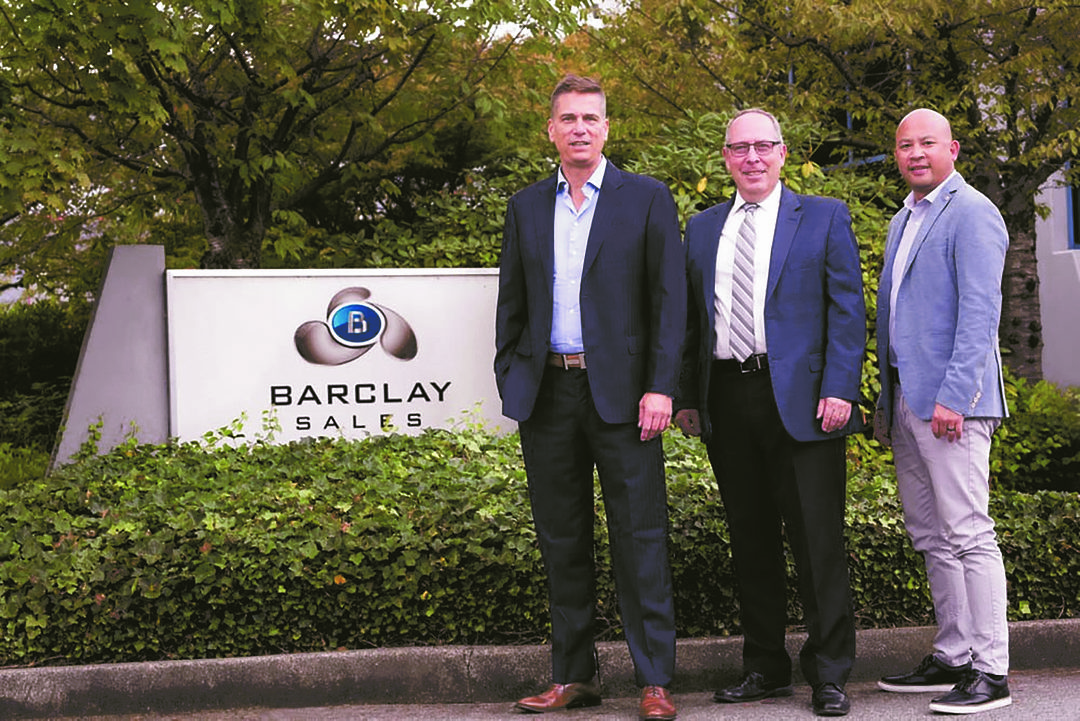Barclay Sales Celebrates 50 Years
The manufacturers’ representative agency learned to be nimble when outside forces required change, and to take calculated risks when needed.

This year marks the 50th anniversary of Barclay Sales (www.barclaysales.com), a manufacturers’ representative company located in western Canada. The company represents 20 manufacturers, and buys and sells from another 15 suppliers. Barclay operates out of a 28,000-square-foot building and warehouse, with stocking inventory. The rep firm focuses on the automation of many administrative duties so “our team can concentrate on serving our customers,” says Jeff Blair, president.
We sat down with Jeff to shine a light on the rep firm, its connection within the channel, and how it has carved its path to fulfill its pledge to be the “best at supporting both the manufacturer and the people who use our products.”
Ruth Mitchell: Please share the background on the company — where it was founded, by whom, original location, territory, lines, and staff?
Jeff Blair: Founded by Bruce Barclay, Barclay Sales started in Port Moody, a suburb of Vancouver, British Columbia in 1971. In 1983, Bruce bought his first warehouse - at 2,500 square feet, as an investment. He offered it to his manufacturers to warehouse their inventory; being on the west coast, Barclay was far from the manufacturing areas. Manufacturers could ship full trailers using the rail system, and we could then offer an advantage over the competitors.
I joined the firm in December 1984 and the two of us worked well together from day one. Bruce always liked the idea of technology and I knew how to make it happen. Back then, inventory was kept in a manual card system, and orders were handwritten to ship from the warehouse. At this time, we started to use a communication device called a telex, which was basically a texting machine. We could receive orders or communication from customers and send orders to the manufacturer. This sped up the time to receive and send orders.
We’ve had many changes in computer systems over the years that have allowed us to automate our inventory and accounting processes. After outgrowing our facilities, we were able to purchase land in 1992 and build the current facility we are in today.
In the early 2000s, I bought into the company and became a partner in the business. From early on, Bruce had an exit plan set and, in 2008, he officially retired. He sold his shares to a new team of longtime employees including myself, Rob Lang and Andrew Dyck. In Alberta, he sold his shares to current employees Darren Jacobs, Michael Macdonald and myself.
RM: What does this milestone mean to you and your team?
JB: This milestone is monumental and very exciting. We are a privately owned company incorporated in 1971, which is very unique nowadays. Many companies fail when the ownership changes. We were able to make the transition of ownership 13 years ago and continue to move forward and are now stronger than ever.
RM: How did you and your team build lasting relationships within the supply chain? And what have you found to be the best ways to strengthen those connections?
JB: We are members in many associations. But to help promote our Barclay brand, we not only join but get involved in board positions to make sure all members are aware of who we are so when we contact them, they are already aware of Barclay Sales.
We were the first agency to have an employee be the chairman of the board (Andrew Dyck) in the history of the Canadian Institute of Plumbing and Heating, a more than 80-year-old association of wholesale distributors, manufacturers and agents in Canada. I am currently on the AIM/R board and moving into an executive position this term.
We also look at ourselves as business partners to our distributors and manufacturers, continually looking for ways to improve the margins for both sides.
RM: Has that changed over the years? Do you think that personal relationships are still important in this era of instant digital communications?
JB: The relationship between the rep and the supply chain has changed. At one time we would be the big personality, and a lot of sales were solely based on personal relationships. While still important today, we need to be stronger businesspeople, find ways to pull the business through for the distributor. We have taken on more roles than just sales. In a lot of cases, we are the marketing, local distribution and customer service for the manufacturer.
To offer all these functions, the manufacturers’ rep must now have a back end of people that a small agency just can’t offer. On the rep side, we need to find a balance to be able to offer these functions and do it profitably. We live in a high tax country, so like Europe, we are constantly trying to find ways to automate the administrative functions of the business so that all people are an asset versus an expense.

RM: Do you see that balance changing as technologies continue to evolve and as the millennial generation takes on leading roles in the supply chain?
JB: Already in our market the under-40s are taking over the management functions in our distribution channel. In the last two years, we have seen many people retire due to COVID-19 forcing them to reassess their lives, instead of working into their golden years. This is leaving large voids of positions, providing opportunities for the millennials to progress faster in their careers than what we experienced in our careers.
Our industry is bringing in well-educated people to manage the businesses. This is much different than in the past, where you could start in the warehouse and end up runing the business through hard work.
RM: How would you describe the role and impact of independent reps in today’s supply chain?
JB: The rep has become more important than ever with the amount of choice out there. The distributor does not have time to pull through business, so the role of managing the channel has transitioned to the reps. As a manufacturers’ rep, we can offer so much more territory coverage and relationships due to multiline selling.
RM: What have been the most effective ways to educate you and your team on new product launches, features, applications, etc.?
JB: We have moved most of the initial training online for efficiency and speed of learning for all sales team members. However, to really learn about a product, you need to get in front of customers, physically or virtually, and tell the product story. The feedback from the customer will help you understand the hot points of the product and how to promote it better for future meetings.
RM: Are you involved in any national, regional or local associations? What are some of the benefits you feel these groups can provide rep agencies?
JB: We belong to many associations to help build contacts in those markets. We operate in multiple markets, residential and commercial plumbing, heating, irrigation and fire protection. Being in the association of that industry and participating in their meetings and trade shows allows us to get to know the members so we can access the market faster and directly. We will have one person from our group oversee getting involved in the association to help build our brand name in that industry.
RM: Is it difficult for agencies to justify the expense of participating in these organizations? Do you believe the value outweighs the investment?
JB: An association is only worth the membership if it provides valuable education, contacts, or helps build your brand. We feel becoming actively involved in the association is key to getting the value for the investment.
RM: Overall, how do you think your firm has been able to achieve 50 years in business and continue to chart annual growth?
JB: To be able to survive the constantly changing world, we have had to quickly change direction when outside forces change. We have made sure that we don’t have one source of income that, if stopped, would put us out of business. We have developed a buy-sell line of products that offers a different relationship with the manufacturer and provides better margin to offer services that may not be affordable by other reps.
We are not afraid to try new things or take calculated risks that may not work all the time, with the goal of providing better and easier ways to deal with us.





